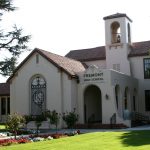Knocking down the ‘brick wall’ for students
At a 2016 board of education meeting, I represented Fremont High School’s Algebra 2 course with an image of a brick wall. In California, two years of math are required for high school students to graduate, yet three years are required for admission to 4-year colleges. So many of our students were failing or not enrolling in their third year of math, Algebra 2, that a brick wall seemed to me to perfectly symbolize the dead end this course had become for these students. Approximately 40% of students enrolled in Algebra 2 did not pass with a C or higher, and for those who came from our most economically disadvantaged feeder school, an alarming 80% received Ds and Fs. We knew that something needed to change if we wanted to give more students the opportunity to continue studying math and the option to pursue a degree at a 4-year institution after high school.
Launching dual enrollment at Fremont High School
At the same time that Fremont was searching for a solution for our Algebra 2 challenge, a local community college, Mission College, was exploring ways to both increase their college completion rate by replacing their remediation math sequence with an accelerated, credit-bearing pathway and to better connect with local high schools as a means to increase enrollment at Mission. Statway, the statistical reasoning math pathway from Carnegie Math Pathways, proved to be a good match for Mission’s own effort to reform remediation, offering an accelerated route for students to fulfill their college math requirement while engaging them in relevant content through collaborative learning. While partnering with Carnegie Math Pathways to implement Statway as their solution, Mission simultaneously connected with us on launching a dual enrollment program that would prepare students for success in college, provide high school and college credit upon successful completion, and also create a pipeline of Fremont students to their campus. Recognizing the opportunity to offer Statway as an alternative to Algebra 2, we were eager to partner with Mission to better prepare students for college and make a 4-year education a viable option for more students.
To successfully bring Statway to our high school, we involved a host of our stakeholders, including educators and administrators from our high school, partner college, and our school’s district administration. Over the course of more than three months, this team worked to coordinate who would teach the course and what the credit structure would look like. We have chosen to offer Statway as a year-long course. As long as students achieve a C grade or higher in both semesters of the course, they earn both high school and college-level credit. In our district, students are advised about which math courses to take based on their interests, but ultimately have the agency to decide for themselves which course is right for them, and they have the opportunity to drop if they feel it isn’t right for their goals. Statway has become an important addition to the math course offerings at Fremont because it provides students with an alternative to Algebra 2.
Since its launch, our dual enrollment program has seen various iterations as we learned what worked and what we needed to adjust in response to unforeseen challenges. Initially, the course was co-taught at Fremont by myself and an adjunct faculty member from Mission, but the following year I was hired as a part-time instructor at Mission in order to teach Statway at Fremont. Over the years, funding sources have changed and even our college partnership has shifted. While our school’s relationship with Mission remains strong, we’ve since transitioned our dual enrollment partnership to Foothill College. While changes have been made behind the scenes, the experience the program has provided for students and faculty, and the outcomes they’ve produced have been consistently meaningful.
Expanding access to 4-year colleges and making math empowering
Dual enrollment Statway at Fremont has welcomed almost two hundred of our students “back to math” and helped create access to 4-year institutions for many who otherwise would have gotten stuck because of Algebra 2. It has dramatically improved the way students perceive themselves—as capable of learning and doing mathematics. And it has created a culture of inclusion: I regularly hear my students coaching each other on note taking and study strategies and checking in on each other’s understanding of the material. Although the vast majority of our Statway students struggled in at least one foundational high school math course, 60–80% of students in the program have earned college math credit through Statway each year.
By helping us knock down the “brick wall” of Algebra 2, our concerted effort with Mission, and now Foothill, to offer Statway as a credit-bearing option at Fremont has helped us convince our students to give math another chance and significantly increased access to 4-year institutions. We are excited to continue offering Statway to expand postsecondary options for our students.
